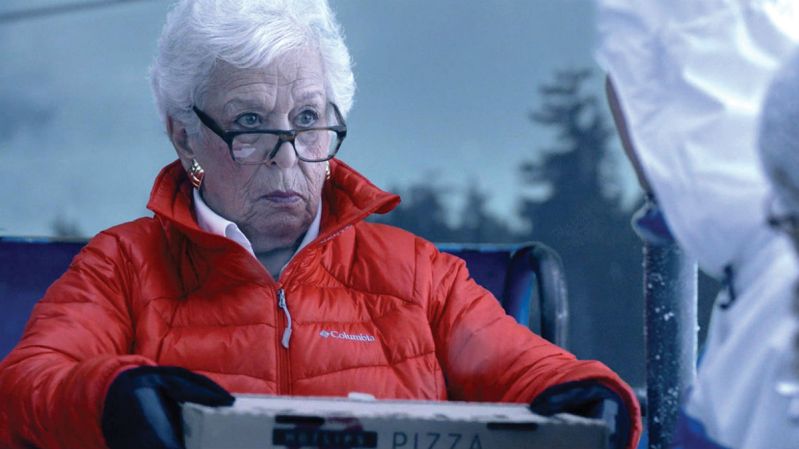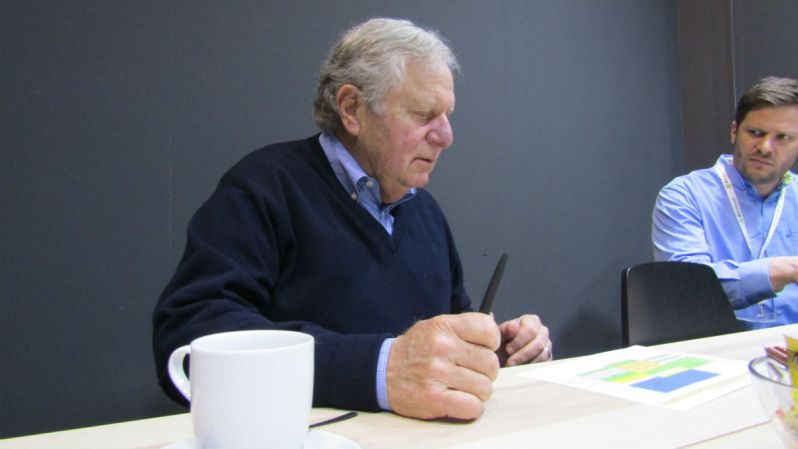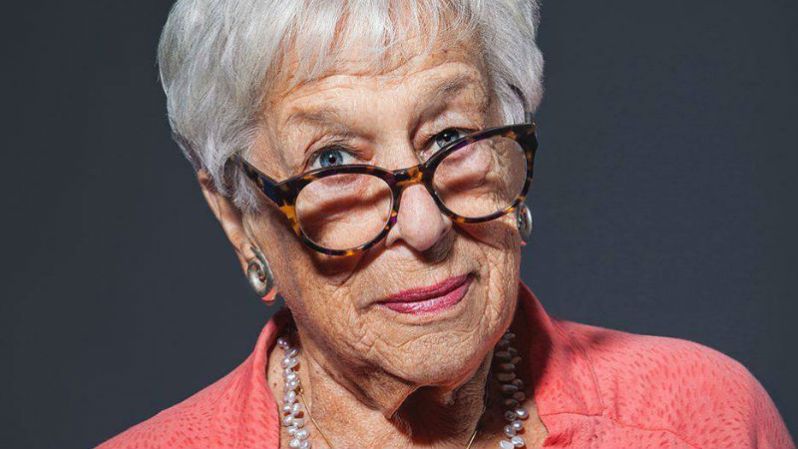First off, if you don’t know what ISPO is, I wrote an article all about it, so give that a look. But the short story is that ISPO is the world’s largest trade fair dedicated entirely to sporting goods, apparel, and technology. Each year, the ISPO Cup award is given to an athlete or outdoorsman (or outdoorswoman!) for marked achievement in his or her field, from mountaineering to professional team sports to an Olympic record and so forth.
In 2018, the ISPO Cup Award went to Gert Boyle, a 93-year-old woman who stands about five feet tall and who has never set a record of any sort in any sport. But she did manage to grow a struggling hat company into one of the world’s most respected, innovative, and successful sportswear companies, and that’s worth something. (In fact, it’s worth more than a billion somethings annually, when “something” refers to U.S. dollars.)
Who is Gert Boyle, exactly, and what is her legacy? We’ll get into that, but for the record, even if the name doesn’t ring a bell, if you’re over the age of 30 or so, you probably know her face. Starting in the mid-1980s, Gert starred in a wildly successful print and television advertising campaign in which she took on the mantle of the Tough Mother who put Columbia Sportswear apparel through arduous batteries of tests, usually with her long-suffering son, Tim, as the hapless victim of the trials.
The Tough Mother persona Gert depicted in those ads was, of course, intended largely for humor and was something of a parody, but whether you call it toughness, fortitude, resilience, mettle, or just about any other word that basically means badass, you’ll be aptly describing this unlikely titan of the sporting goods world. Many of the events of her life would have worn out or outright broken many people. Instead, Gert thrived — so much so that, at 93, she still goes to work at Columbia’s Portland, Oregon, headquarters just about every day of the week.
When Gertrude Boyle arrived in America in the summer of 1937, she was 13 years old, spoke no English, and had little idea of what to expect from the life ahead of her. But her father had clearly seen what awaited a Jewish family like theirs if they stayed in Germany. Her father, Paul Lamfrom, had run a highly successful shirt manufacturing company north of Munich, and in their new home of Portland, he again went into the clothing business, this time by establishing a hat company. As Gert shares in her 2005 memoir One Tough Mother, this shop, dwarfed by the size of the business the family had left behind, was named the Columbia Hat Company, simply because Paul had noted that many other Portland area businesses were named after the Columbia River that winds about the town.

I’m not going to turn this into a biography about Gert Boyle, largely because she already wrote that herself (see above). What I will do is share two notable things that happened in her life to which her response has made all the difference and can even stand as a model for the rest of us.
The first was a tragedy: Gert’s husband Neal took the reins of the Columbia Hat Company and turned it into a modest sporting apparel seller, managing the business while she ran the household until his sudden death in December of 1970. Neal died within hours of first experiencing chest pains and left Gert not only to raise a family with three kids, but also as the head of a company when she had next to no practical business experience. Rather than simply selling off the company, Gert, together with her son Tim, decided to make a go of running a sporting apparel business.
The second notable decision Gert Boyle made was to not sell the company a few years later, even though the endeavor was not (yet) profitable. Faced with selling for a modest fee or sticking with an all but failing brand in which she could yet see potential, Gert kept Columbia in the family.

After reading Gert Boyle’s memoir and speaking at length with Tim Boyle (CEO of the company) and Joe Boyle (Tim’s son, who is the current president of the Columbia brand), I came to appreciate how the company has been so successful, and it dovetails with why Gert Boyle makes a logical recipient for an award usually reserved for pioneers or top-tier achievers in the sporting world. The driving force behind every Columbia product and initiative has always been a commitment to quality, and the brand has proven willing to admit missteps and re-direct when necessary. As tough as Gert plays it, she has also listened to good advice. She was not an early fan of the Tough Mother ads when an agency proposed them, but she was willing to listen to experts and try the approach. And when core fans, then a wider audience, responded with enthusiasm, she was only too happy to embrace the Tough Mother persona and commit to the campaign.
I sat down with Tim Boyle at the 2018 ISPO conference a few hours before he would accept the ISPO Cup award on behalf of his mother (while she still goes to work, she does not often travel across an ocean and two continents). He shared a unique perspective on why the family had stuck with the business and why it ultimately succeeded. When he and his mother took over Columbia, he did not see it “as a family heirloom, but really as a means for survival.” What they had was a struggling company, but that was better than nothing. The Boyles don’t tend to tout Columbia as a family-run company either (though indeed it is essentially that, and in its fourth generation, no less). Instead, as Tim Boyle describes it, they see it as a “public company that happens to be largely managed by family members.” So while Columbia is still the Boyle family’s “means for survival,” today this billion-plus dollar global brand is not at much risk of foreclosure or failure.
During my time at ISPO, I spent a good while chatting with Joe Boyle as well, and in a later email exchange, he shared some insight that was so well put, I thought I’d just use the brand president’s own words:
“The more I thought about the question of separating personal life from professional life,” Joe wrote, “the one thing that remains a constant [I] don’t ever take anything for granted. At least that is the way I have approached both my personal life and my professional life in the business, and I think Gert would agree with that. At the end of the day, we started as a small family business, grew into a larger family business, and then pivoted to a publicly traded, multinational corporation that happens to have family members both invested in the company and integrated into the culture of running the daily operations. All of this I never take for granted, and that’s a lot of what drives me to continue our growth and leadership in the industry. We’ve got a lot of people counting on us not taking anything for granted.”
Still, serving as the chair of a massively successful active apparel brand — Tim pointed out that Columbia is an apparel brand across myriad categories, from fishing shirts to casual wear, not just an outerwear company as many tend to think — doesn’t necessarily make you a logical choice for a sporting award. But when that company has developed some of the most innovative thermal technology the industry has ever seen, such as the Omni-Heat lining, that helps. So does the breathable yet 100 percent waterproof OutDry fabric. And so on. But lots of companies have developed cool (or warm or dry, if you’ll let the pun serve) apparel technologies. And lots of companies have outfitted Olympic athletes, as Columbia did this year at PyeongChang 2018. And yes, lots of company executives have dedicated countless hours and millions of dollars to charities like the Special Olympics and various children’s charities, including CASA.

When you put it all together, though, you get a product that is truly unique. Gert Boyle never planned to head a global outdoor and active apparel business. Tim planned to be a journalist, not the CEO of such an enterprise. Joe probably had an inkling of what his career might hold, but he still had to reach out and grab it instead of coasting along for the ride. So the ISPO Cup awarded to Gert Boyle in early February 2018 was certainly in recognition of one woman’s impact on the sporting world writ large, but it stands for much more than that. It stands for the massive impact a person, people, and even brands can have when they are informed and inspired by a devotion to making quality products and doing good works.



